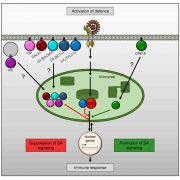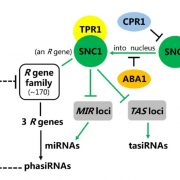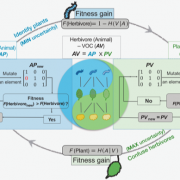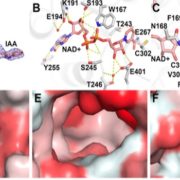Listening to the whispers in the air: Plant eavesdropping in action
 Plants release a variety of volatile organic compounds (VOCs), including green leaf volatiles (GLVs), terpenoids, and amino acid derivatives, in response to herbivore damage and injury. Healthy neighboring plants detect these VOCs as warning signals, prompting them to activate defense mechanisms. This process of plant-to-plant communication or plant eavesdropping has been observed several times, but now Aratani et al. were able to define the exact compounds and mechanism via a simple, strategic experimental setup utilizing the transgenic Arabidopsis expressing a calcium biosensor. Real-time changes in the cytosolic calcium levels, [Ca2+]cyt, were observed in the Arabidopsis plants following exposure to VOCs emitted by damaged plants. Among the several VOCs tested in this study, (Z)-3-hexenal (Z-3-HAL) and (E)-2-hexenal (E-2-HAL) caused a rapid and significant increase in [Ca2+]cyt, spreading from the tip to the base regions within minutes. Exposure to Z-3-HAL and E-2-HAL activated genes related to plant defense mechanisms, such as heat and oxidative stress responses and jasmonic acid signaling. Blocking the increase in [Ca2+]cyt using chemical inhibitors prevented the activation of these defense-related genes, and this effect was reversible. However, when Z-3-HAL was applied directly to a specific plant part, it induced a local increase in [Ca2+]cyt, without systemic propagation to other unstimulated parts. These results suggest that [Ca2+]cyt increases are essential for initiating plant defense responses but they do not trigger long-distance calcium signals within the plant. The rapid changes in [Ca2+]cyt expression in the guard cells, followed by mesophyll and vasculature cells upon Z-3-HAL exposure, was also quantified using tissue-specific high-resolution imaging and mutant analysis, which suggested that VOC (particularly GLV) sensory transduction begins with GLV entry through stomata, subsequently activating plant defense responses in mesophyll and vasculature cells of Arabidopsis leaves. (Summary by Rajarshi Sanyal, @rajarshi_sanyal) Nature Comms. 10.1038/s41467-023-41589-9
Plants release a variety of volatile organic compounds (VOCs), including green leaf volatiles (GLVs), terpenoids, and amino acid derivatives, in response to herbivore damage and injury. Healthy neighboring plants detect these VOCs as warning signals, prompting them to activate defense mechanisms. This process of plant-to-plant communication or plant eavesdropping has been observed several times, but now Aratani et al. were able to define the exact compounds and mechanism via a simple, strategic experimental setup utilizing the transgenic Arabidopsis expressing a calcium biosensor. Real-time changes in the cytosolic calcium levels, [Ca2+]cyt, were observed in the Arabidopsis plants following exposure to VOCs emitted by damaged plants. Among the several VOCs tested in this study, (Z)-3-hexenal (Z-3-HAL) and (E)-2-hexenal (E-2-HAL) caused a rapid and significant increase in [Ca2+]cyt, spreading from the tip to the base regions within minutes. Exposure to Z-3-HAL and E-2-HAL activated genes related to plant defense mechanisms, such as heat and oxidative stress responses and jasmonic acid signaling. Blocking the increase in [Ca2+]cyt using chemical inhibitors prevented the activation of these defense-related genes, and this effect was reversible. However, when Z-3-HAL was applied directly to a specific plant part, it induced a local increase in [Ca2+]cyt, without systemic propagation to other unstimulated parts. These results suggest that [Ca2+]cyt increases are essential for initiating plant defense responses but they do not trigger long-distance calcium signals within the plant. The rapid changes in [Ca2+]cyt expression in the guard cells, followed by mesophyll and vasculature cells upon Z-3-HAL exposure, was also quantified using tissue-specific high-resolution imaging and mutant analysis, which suggested that VOC (particularly GLV) sensory transduction begins with GLV entry through stomata, subsequently activating plant defense responses in mesophyll and vasculature cells of Arabidopsis leaves. (Summary by Rajarshi Sanyal, @rajarshi_sanyal) Nature Comms. 10.1038/s41467-023-41589-9







